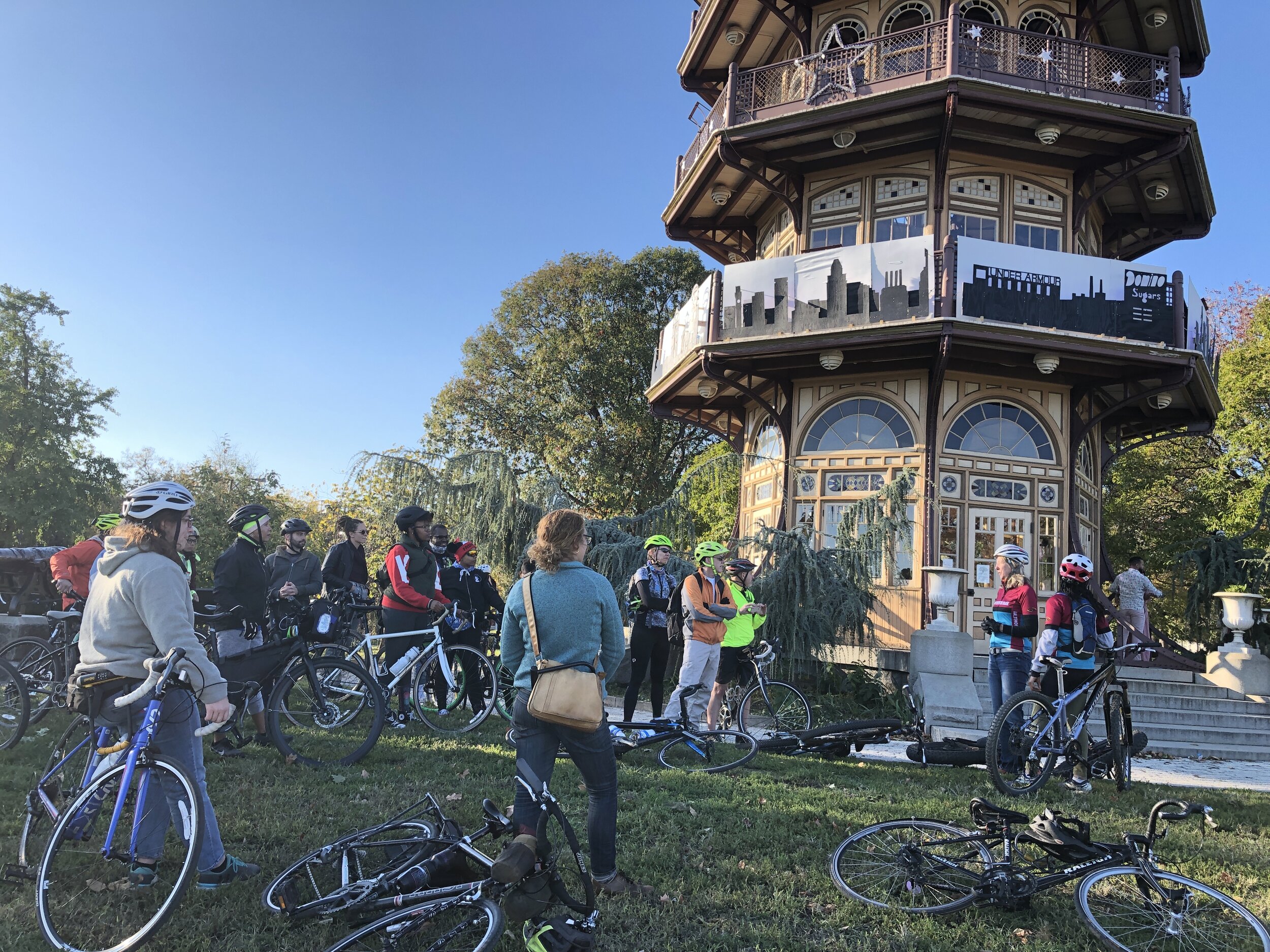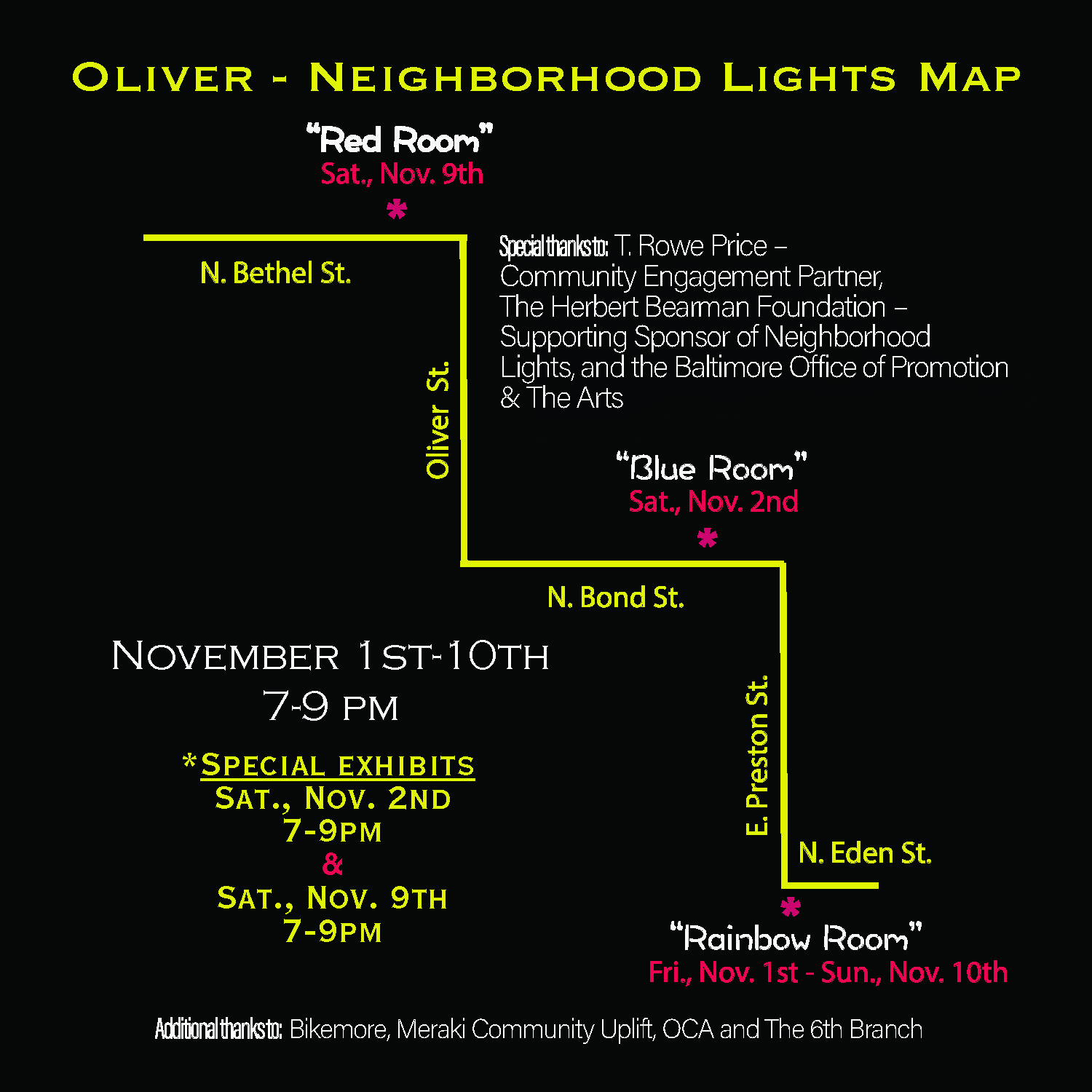A key part of our mission at Bikemore is improving connectivity to our public parks - a core piece of building a safer, healthier, and more livable city. Back at our October Bike Leaders Breakfast, our long-time friend and public artist Graham Coreil-Allen brought flyers and shared the goals of Arches & Access, an event he co-organized, to illuminate the connections between West Baltimore neighborhoods and Druid Hill Park.
We showed up in West Baltimore on the night of Sunday, November 3rd, joining over three hundred residents from the neighborhoods surrounding Druid Hill Park who came together to create a space for a roving block party and parade on Druid Park Lake Drive. People danced, marched, performed, and celebrated access to public green space.
The event was first conceived by artist Jessy DeSantis and advocate Courtney Bettle, both Reservoir Hill residents, as an idea based off DeSantis’ colorful painting of the historic arch on Madison Avenue and Druid Park Lake Drive. Later teaming up with Coreil-Allen, who lives on Auchentoroly Terrace, they organized a light exhibit through the Neighborhood Lights initiative of the Brilliant Baltimore/Festival of Light and Literature. Together, they expanded their original vision of lighting up the arch to include a parade of solar-powered lights leading into the park and ending at an equally vibrant Rawlings Conservatory.
“Collectively they expanded the vision to include solar powered lights leading into the park, activated by a joyful community parade showing what life could be like without highways hindering pedestrian access to Druid Hill Park.”
A parade studded with a marching band, Benevolent Bubbles’ lighted bikes, and speeches from neighborhood leaders, including 7th District Councilperson Leon Pinkett, created a welcoming, exciting environment that attracted many who joined from side streets and through the Big Jump.
The organizers shared that by the end of the night, residents were already looking forward to making Arches & Access an annual event to unite communities of West Baltimore with Druid Hill Park. Through a lively parade, they truly accomplished their goal of “show[ing] what life could be like without highways hindering pedestrian access to Druid Hill Park.”
This need for safe access for people who bike, walk, and use mobility devices is why we’ve been building relationships in the neighborhoods surrounding Druid Hill Park for years. When the Druid Hill Expressway was built, the five-lane highway separated neighbors from safely and comfortably accessing a vital greenspace in the city. When we installed the Big Jump along 28th St and Druid Park Lake Drive, it created access for people to travel between West and Central Baltimore. It decreased the speed of traffic and shortened crosswalks to make it easier for neighbors to walk to Druid Hill Park.
The liveliness of the celebration that neighbors created reinforced that the work we do at Bikemore is not to reinvent the wheel. Communities have always known what they want: streets for people.
We are constantly seeking to uplift the strength, creativity, and power that residents already have.
This is why we spent more of our capacity in 2019 than ever on community building. We don’t need to be the center of work for transportation change. In creating an equitable transit system, the process is just as important as the deliverable. That means that we have to center the voices of people who have been advocating for safer streets that have also been historically and structurally ignored.
In 2020, we want to support more of our neighbors - so that they can create spaces that prioritize connectivity and accessibility to parks in our city; so that they can activate their community; so that they can be the leaders of political change in Baltimore.
Help us support changemakers across Baltimore by donating to Bikemore today. We can build Complete Streets together.
Make a Direct Action Donation (501c4)
Direct Action donations are our greatest need. They can fund everything we do, including directly lobbying elected officials, running grassroots organizing campaigns, and advocating for or against legislation. They are not tax-deductible.
Make a Charitable Donation (501c3)
Charitable donations fund our education, organizing, and programming, and may be tax-deductible.
Read more about Arches & Access at the blog post from TAP Druid Hill.





















